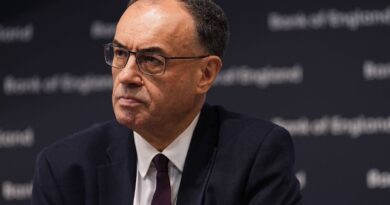U.S. economy went into reverse in the first quarter, new GDP data shows
U.S. economic growth slowed sharply in the first quarter of 2025 as businesses rushed to stockpile goods ahead of President Trump’s sweeping tariff policies.
The nation’s gross domestic product — the total value of products and services — grew at a -0.3% pace, down from 2.4% in the final three months of 2024, the Commerce Department reported Wednesday in its initial GDP estimate. The U.S. economy was forecast to show 0.8% growth in the first three months of 2025, according to the average estimate of economists polled by FactSet.
The slowdown comes amid growing concerns that Mr. Trump’s wide-ranging tariffs could disrupt the U.S. economy, with some economists raising the chances of the U.S. slipping into a recession in 2025. Although the Trump administration’s blanket tariffs were announced on April 2 — after the end of the quarter — businesses sought to get ahead of the impact of the import duties by front-loading purchases early in the year.
Still, the report may not fully reflect the state of economic growth, economists cautioned, noting that the figures are likely to be noisy because of the surge in imports as businesses sought to get ahead of tariffs. A rise in imports may appear to lower economic growth and show a shift away from domestic consumption, but that doesn’t tell the whole story, economists note.
“There has never been a recession caused by imports,” Oxford Economics deputy chief U.S. economist Michael Pearce wrote in an April 29 research note. “While they are recorded as a subtraction from GDP, imports show up as an offsetting positive elsewhere because they show up in increased consumption or business investment, or they are recorded as an increase in inventories.”
The U.S. economy is expected to show slower growth in 2025, partly due to the impact of Mr. Trump’s tariffs, which are import duties paid by American companies like Walmart or Target. When faced with higher tariffs, companies typically pass on all or some of the costs to shoppers, which can depress consumer spending.
GDP growth is forecast to slow to 1.9% in 2025, according to FactSet. That’s down from 2.8% in 2024.
“[T]he inflation data will show when the price increases of tariffs hit consumers, which will deliver a real income shock that we expect to weigh heavily on spending growth,” Pearce said.




